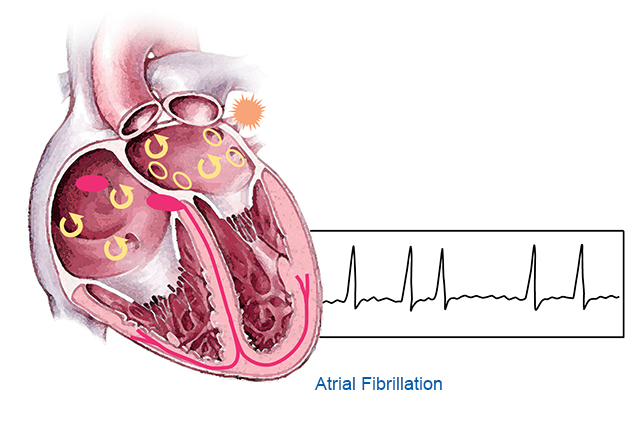New Treatments for a Growing Epidemic
By Bryan Lawlor
[email protected]
Atrial fibrillation is a heart rhythm disorder affecting millions of people in the United States. The number of people diagnosed is expected to increase significantly over the next several decades. This is largely due to our aging population and the many associated health conditions such as heart disease, high blood pressure, diabetes, and obesity that can all contribute to the development of atrial fibrillation.
Atrial fibrillation is characterized by disorganized electrical activity originating from the top chambers of the heart (particularly the left atrium) that causes the heart to squeeze irregularly, and usually faster than normal. This dysfunction can ultimately cause blood clots to form in the left atrial appendage, a small out-pouching of the left atrium, and can dislodge into the bloodstream to cause a stroke.
Treatment focuses on symptom management and blood thinning medications in order to reduce the risk of strokes. Common symptoms include chest pain, shortness of breath, and palpitations. Sometimes though, symptoms can be quite subtle, manifesting as fatigue or low energy.
How affected people are by atrial fibrillation can be highly variable, and typically depends on what symptoms they experience, as well as the frequency and length of episodes. Patients who are in atrial fibrillation all the time may even develop congestive heart failure. Some individuals may be truly asymptomatic, but this can delay diagnosis and treatment.
Unfortunately there is no cure for atrial fibrillation, but there are several interventions to suppress it. Lifestyle changes, including avoidance of alcohol and losing any excess weight, can significantly reduce atrial fibrillation episodes. Medical therapy can include medications to slow down the heart rate, or stronger medications, called anti-arrhythmic medications, to maintain a normal heart rhythm.
Over the past decade, the ablation procedure, which directly targets and attempts to eliminate the electrical triggers for atrial fibrillation, has become a more common and effective treatment option. The ablation procedure is better than medications at suppressing atrial fibrillation and is now offered as a first-line therapy. There is ongoing investigation into new ablation technology that may hopefully offer better suppression in the future.
Lastly, there are more treatment options for stroke risk reduction. Patients have several options for effective and convenient blood thinning medications. There are now also several devices, including the Watchman device, which can be implanted into the left atrial appendage for patients who cannot safely tolerate blood thinners. A successful implant is similarly effective at reducing the risk of stroke and can allow the patient to come off their blood thinning medication.
Overall, while the prevalence of atrial fibrillation is increasing and the potential complications of atrial fibrillation are becoming more apparent, the treatment options are becoming more effective and widespread to help affected patients.

